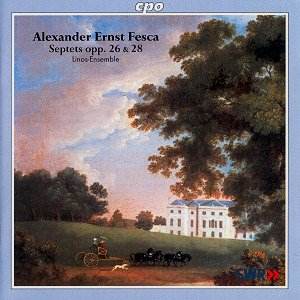It is, indeed, worth taking the risk and trying this
disc, for Fesca’s music is fresh, well-crafted and delightful. Do not
look for anything deep, and you will not be disappointed. Possibly because
of Fesca’s easy-going gait, I personally found it difficult to listen
to both septets one after the other. They are best enjoyed one at a
time, perhaps as an apéritif to an extended listening session
(they both last just over half and hour).
Alexander Fesca studied at the Royal Academy of Arts
in Berlin (1834-7). His life-span was cruelly short: he died at the
age of 28. Nevertheless, he left quite a body of music, including over
120 songs, six piano trios, four string quartets and several stage works.
Robert Schumann, reviewing some of Fesca’s early piano pieces in the
Neue Zeitschrift für Musik, wrote that these pieces, ‘even
if not manifesting a unique power and view of art, all contain within
a fresh seed of life’. This comment seems to apply just as aptly to
the Septets. In a refreshing burst of honesty from a programme-note
writer, Bert Hagels in the accompanying booklet to this disc writes
that the two septets, ‘are certainly not among the outstanding chamber
works of the nineteenth century, but to cite a reviewer of those times,
they nevertheless belong to the ‘field of higher, nobler entertaining
music’’.
Never let it be said that a minor key necessarily implies
depth or Sturm und Drang, therefore. These qualities are notably
absent from Fesca’s musical vocabulary in these pieces, replaced by
a marked approachability.
Both septets are scored for piano, oboe, horn, violin,
viola, cello and double-bass. The first, in C minor, dates from 1842.
The first movement exudes a sense of fun, and the players of the Linos-Ensemble
play with a youthful vigour entirely appropriate to this. In particular,
the pianist (Konstanze Eickhorst) plays the myriad scales and arpeggios
glowingly and winningly. Only her chordal work seems weak, needing a
fuller tone at times.
There seems not to be a weak link amongst the Linos-Ensemble,
with much expressive playing in the Andante con moto. The cellist (Mario
Blaumer) is worthy of special mention for his lyrical, singing line
in the Trio of the Scherzo. The problem, compositionally, comes with
the finale. When Fesca tries to be too dramatic, his invention becomes
decidedly thin and the nine-minute duration of this movement is, admittedly,
wearing. The major recompense comes in the shape of the pianist's superb
contributions towards the close, with their admirably controlled left
hand figuration.
The D minor Septet followed close on the heels of the
first. Sharing the same instrumentation, being similarly in a minor
key and being so soon afterwards, it is inevitable that there will be
a certain sameness between the two: even the tempo marking of the first
two movements is identical. This does not quell the flames of the Linos
Ensemble's enthusiasm, however. The spirited exchanges of the first
movement are a joy to hear: indeed, I get the impression that these
pieces may well be even more fun to play than to listen to. The finale
has a gypsy/folksy element to it which is most affecting.
The Linos’s sense of ensemble is impeccable, whether
they are exchanging phrases or playing fortissimo chords absolutely
together. Their enthusiasm is infectious. CPO’s recording is clear,
well-balanced and non-interventionist.
Colin Clarke

